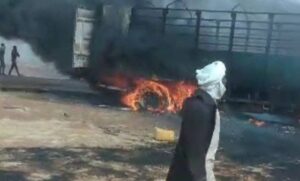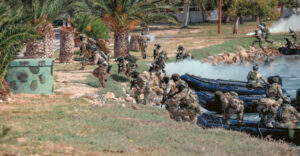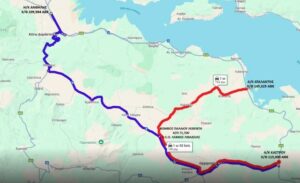Jihadists have killed at least 32 people by opening fire on a convoy of civilian vehicles escorted by the army and mercenaries from the Russian company Wagner in northern Mali, where the armed forces said yesterday Saturday that they were pursuing “the terrorists” who carried out the attack.
The raid on several dozen vehicles took place Friday in Combe, about thirty kilometers from the city of Gao, an area often torn by violence where armed forces have repeatedly conducted anti-jihadist operations.
In a statement last Saturday night, the Joint Chiefs of Staff called it an action by a “group of multiple terrorists.”
During fighting, “hidden terrorists deliberately targeted civilian passengers” of vehicles, according to the staff, in which three vehicles were hit, resulting in the “deaths of 25 civilians” and the injury of 13 others, “the majority of them young foreign gold miners” who were traveling to a gold mine in Gao.
The Malian armed forces “are pursuing the terrorists, perpetrators of the attack on the convoy”. Clearance operations allowed the discovery of “19 bodies of terrorists who had been abandoned” as well as weapons, according to the same source.
Earlier yesterday, an account given by a local elected official, on condition of anonymity, spoke of “32 dead” both “citizens” and “military personnel.”
This account was confirmed by a source at a French News Agency non-governmental organization operating in the area.
“Jihadists ambushed on Friday between Gao and Ansogo” (north) against “a convoy of civilian vehicles escorted by Mali soldiers and (Russian) mercenaries from Wagner,” another local official, also speaking on condition of anonymity, told AFP earlier.
A survivor, with a head wound, said he saw gunmen“firing at the convoy from two sides”and “many dead police and soldiers.”
A transport sector trade unionist in Mali, who spoke on condition of anonymity, said that “according to a transporter who escaped, jihadists ambushed the convoy and started shooting at everyone indiscriminately to cause the maximum number of casualties.”
According to an elected official in northern Mali, at the time of the attack, members of the NDF and Wagner mercenaries were riding in “more than ten vehicles” and were tasked with “guaranteeing the passage of civilians”who were traveling in “22 minibuses, six large buses and eight trucks.”
“At least five trucks were destroyed by Islamic State (IS) jihadists”(IS), he added.
There has been no claim of responsibility for the attack at this stage.
The Ansogo-Gao road axis in northern Mali has in recent months become a theater of repeated attacks attributed to jihadists or gangs robbing civilians.
In early January, the Malian army announced that it had captured a “first-ranking leader” of the Islamic State in the Greater Sahara (ISIS) group and killed his fighters during an operation in the Gao region.
The staff presented the arrested man, whom it named as Abu Has, as“a long-sought terrorist known to intelligence agencies for his responsibility and coordination of many of the worst atrocities and abuses against populations in Menaka and Gao prefectures and attacks against the IDF.”
Since 2012, Mali remains mired in a serious security crisis, caused mainly by the activities of organizations swearing allegiance to either Al Qaeda or the IC, as well as gangs of thugs.
The country of Sahel is ruled by a military junta, following two coups in 2020 and 2021. After they took power, the military ended the country’s historic alliance with former colonial power France and turned to Russia for political and military support.
The ongoing jihadist attacks call into question the junta’s rhetoric, which asserts that its breakthrough strategy and new alliances and the escalation of military operations have reversed the trend in the fight against jihadists.
Ask me anything
Explore related questions





